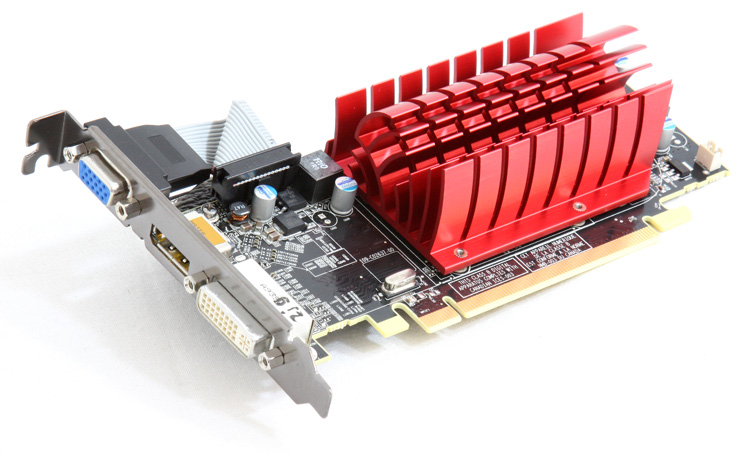Specifications and features
Well now -- today ATI is launching their most low-cost series of graphics cards in the 5000 range. You guys know this under codename Cedar and if we dig a little deeper, this would be the RV810 GPU.
We already spilled the beans a little, this card has nothing to do with gaming, though in all honesty it's still twice as fast as any standard embedded IGP out there. But with merely 80 shader processors, sure this has very little to do with gaming in the year 2010.
But what can you do with the Radeon HD 5450 then ? Well first off, it's certainly a diverse graphics card. The reference sample we received already has thee monitor outputs, that offers flexibility. Now armed with Eyefinity support you can drive up-to 3 monitors simultaneously as well, and sure again .. not for gaming, but for desktop usage or a nice presentation that kicks ass at 49 USD -- I really don't even want to mention the 299 USD Matrox Triplehead2Go anymore here as that product just doesn't make sense any longer.
|
Process |
40nm |
|
Transistors |
292M |
|
Engine Clock |
650 MHz |
|
Stream Processors |
80 |
|
Compute Performance |
104 GFLOPS |
|
Texture Units |
8 |
|
Texture Fillrate |
5.2 GTexels/s |
|
ROPs |
4 |
|
Pixel Fillrate |
2.6 Gpixel/s |
|
Z/Stencil |
10.4 GSamples/s |
|
Memory Type |
DDR3 / DDR2 |
|
Memory Clock |
Up to 800 MHz |
|
Memory Data Rate |
Up to 1.8 Gbps |
|
Memory Bandwidth |
Up to 12.8 GB/s |
|
Typical Board Power |
19.1 W |
|
Idle Board Power |
6.4 W |
So we determined that the Radeon HD 5450 has only 80 Stream processors, to reflect that number; the most high-end Single GPU from ATI has 1600 of em. Quite a difference. But the 80 Shader processors can still be used to assist several compute based applications, it can speed up your Flash animations, help along with video transcoding but most of all the 80 Shader processors can be utilized with software like Media player Classic HT to optimize image quality (post process) with better colors, depth and image sharpening. We'll show you that in this article.
The card also embeds the updated UVD 2.0 engine to fully help accelerate and decode high-definition content like Blu-ray. We'll talk about UVD 2.0 in a minute though. Let's sift through a comparison.
| Radeon HD 5450 | Radeon HD 5670 | Radeon HD 5750 | Radeon HD 5770 | Radeon HD 5870 | |
| Process | 40nm | 40nm | 40nm | 40nm | 40nm |
| Transistors | 292M | 627M | 1.04B | 1.04B | 2.15B |
| Core Clock | 650 MHz | 775 MHz | 725 MHz | 850 MHz | 850 MHz |
| Shader Processors | 80 | 400 | 720 | 800 | 1600 |
| Compute Performance | 104 GFLOPs | 620 GFLOPs | 1.008 TFLOPs | 1.36 TFLOPs | 2.72 TFLOPs |
| Texture Units | 8 | 20 | 36 | 40 | 80 |
| Texture Fillrate | 5.2 GTexels/s | 15.5 GTexels/s | 25.2 GTexels/s | 34 GTexels/s | 68.0 GTexels/s |
| ROPs | 4 | 8 | 16 | 16 | 32 |
| Pixel Fillrate | 2.6 GPixels/s | 3.2 GPixels/s | 11.2 GPixels/s | 13.6 GPixels/s | 27.2 GPixels/s |
| Z/Stencil | 10.4 GSamples/s | 24.8 GSamples/s | 44.8 GSamples/s | 54.4 GSamples/s | 108.8 GSamples/s |
| Memory Type | GDDR3/2 | GDDR5 | GDDR5 | GDDR5 | GDDR5 |
| Memory Clock | 800~900 MHz | 1000 MHz | 1150 MHz | 1200 | 1200 MHz |
| Memory Data Rate | 1.8 Gbps | 4.0 Gbps | 4.6 Gbps | 4.8 Gbps | 4.8 Gbps |
| Memory Bandwidth | 12.8 GB/s | 64 GB/s | 73.6 GB/s | 76.8 GB/s | 153.6GB/s |
| Maximum Board Power (TDP) | 19W | 61W | 86W | 108W | 188W |
| Idle Board Power | 6W | 14W | 16W | 18 | 27W |
As you can see, power consumption wise these puppies are going to shine, not even a 6-pin power cable connector is needed as the peak wattages are well below the 75 Watt PCIe slot limitation. The maximum wattage (TDP) is just 19 Watts and when the card is idling it will use up only 6W of power thanks to many clever power saving scheme's and well, the lack of huge numbers of transistors.
The 5450 infact achieves a low 6W IDLE power consumption by clocking down in several power stages. Thus a low engine (core) clock frequency with lowered voltages and lower GDDR3 memory power. Clocked down the GPU runs 157 MHz from 650 MHz and the memory 200 MHz, coming from 900 MHz.

